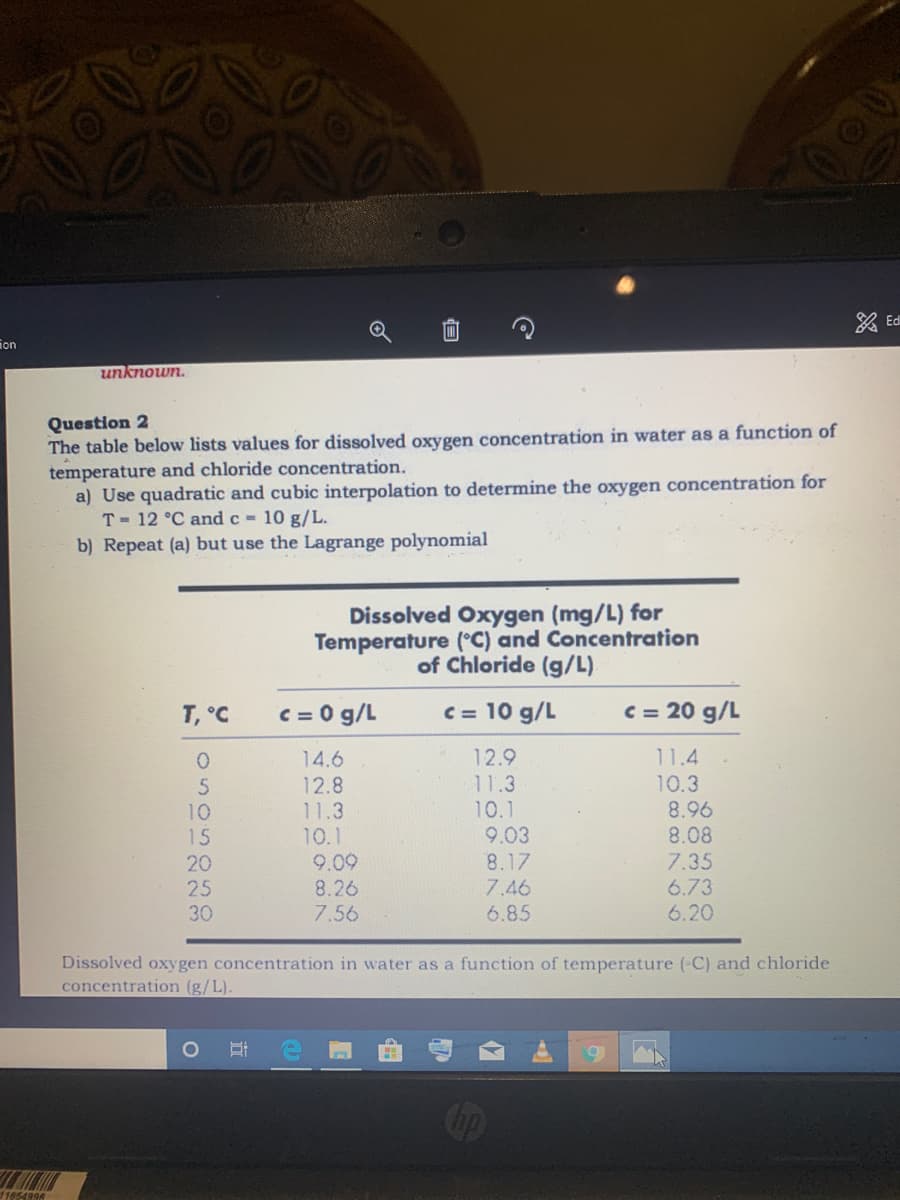Question 2 The table below lists values for dissolved oxygen concentration in water as a function of temperature and chloride concentration. a) Use quadratic and cubic interpolation to determine the oxygen concentration for T- 12 °C and c- 10 g/L. b) Repeat (a) but use the Lagrange polynomial
Question 2 The table below lists values for dissolved oxygen concentration in water as a function of temperature and chloride concentration. a) Use quadratic and cubic interpolation to determine the oxygen concentration for T- 12 °C and c- 10 g/L. b) Repeat (a) but use the Lagrange polynomial
Chemistry
10th Edition
ISBN:9781305957404
Author:Steven S. Zumdahl, Susan A. Zumdahl, Donald J. DeCoste
Publisher:Steven S. Zumdahl, Susan A. Zumdahl, Donald J. DeCoste
Chapter17: Spontaneity, Entropy, And Free Energy
Section: Chapter Questions
Problem 128IP: Some nonelectrolyte solute (molar mass = 142 g/mol) was dissolved in 150. mL of a solvent (density =...
Related questions
Question

Transcribed Image Text:on
11654996
unknown.
Question 2
The table below lists values for dissolved oxygen concentration in water as a function of
temperature and chloride concentration.
a) Use quadratic and cubic interpolation to determine the oxygen concentration for
T= 12 °C and c= 10 g/L.
b) Repeat (a) but use the Lagrange polynomial
T, °C
0
5
10
15
20
25
30
Dissolved Oxygen (mg/L) for
Temperature (°C) and Concentration
of Chloride (g/L)
c = 10 g/L
12.9
11.3
10.1
O
c = 0 g/L
14.6
12.8
11.3
10.1
9.09
8.26
7.56
9.03
8.17
7.46
6.85
c = 20 g/L
11.4
10.3
hp
YOU
8.96
8.08
7.35
6.73
6.20
Dissolved oxygen concentration in water as a function of temperature (-C) and chloride
concentration (g/L).
Expert Solution
This question has been solved!
Explore an expertly crafted, step-by-step solution for a thorough understanding of key concepts.
Step by step
Solved in 2 steps

Knowledge Booster
Learn more about
Need a deep-dive on the concept behind this application? Look no further. Learn more about this topic, chemistry and related others by exploring similar questions and additional content below.Recommended textbooks for you

Chemistry
Chemistry
ISBN:
9781305957404
Author:
Steven S. Zumdahl, Susan A. Zumdahl, Donald J. DeCoste
Publisher:
Cengage Learning

Chemistry: An Atoms First Approach
Chemistry
ISBN:
9781305079243
Author:
Steven S. Zumdahl, Susan A. Zumdahl
Publisher:
Cengage Learning


Chemistry
Chemistry
ISBN:
9781305957404
Author:
Steven S. Zumdahl, Susan A. Zumdahl, Donald J. DeCoste
Publisher:
Cengage Learning

Chemistry: An Atoms First Approach
Chemistry
ISBN:
9781305079243
Author:
Steven S. Zumdahl, Susan A. Zumdahl
Publisher:
Cengage Learning


Physical Chemistry
Chemistry
ISBN:
9781133958437
Author:
Ball, David W. (david Warren), BAER, Tomas
Publisher:
Wadsworth Cengage Learning,